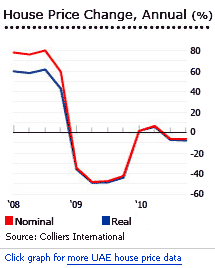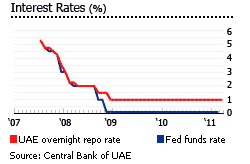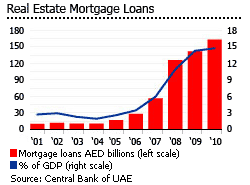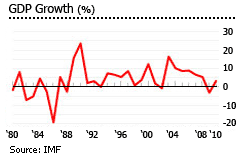Dubai recovering, Abu Dhabi still struggling

There are already signs that Dubai property market is recovering while its neighboring Abu Dhabi, UAE´s capital, is still struggling.
"Dubai is close to the bottom. I don´t think Abu Dhabi has reached the bottom yet," said Craig Plumb of Jones Lang LaSalle UAE.
The Dubai residential property price index (RPPI)—all residential, published by Reidin.com, rose by 7.5% in January 2012 from a year earlier. In contrast, the Abu Dhabi RPPI—all residential dropped 4.1% over the same period.
However, this conceals price movements for different property types. During the past several months, prices of villas have been rising while apartment prices continue to plunge. During the year to January 2012:
| PROPERTY TYPE | |
| DUBAI | |
| Villa | |
| Apartments (All) | |
| Less than 51 sq.m. | |
| 51 - 100 sq. m. | |
| 101 - 150 sq.m. | |
| More than 150 sq. m. | |
| Residential propoerty price index-all residential | |
| ABU DHABI | |
| Villa | |
| Apartments (All) | |
| Less than 51 sq.m. | |
| 51 - 100 sq. m. | |
| 101 - 150 sq.m. | |
| More than 150 sq. m. | |
| Residential propoerty price index-all residential | |
| Source: Reidin.com
|
|
Reidin’s Dubai RPPI covers seven cities, eight main districts and four major developments. On the other hand, the Abu Dhabi RPPI covers seven cities and four main districts.
Dubai’s most desirable districts like Emirates Living, Downtown Dubai, Dubai Marina and Palm Jumeirah have experienced healthy house price rises in the past several months. In contrast, house prices continue to fall in less desirable areas like International City and Dubailand.
The total value of property transactions in Dubai rose by 14% to AED142.9 billion (US$38.9 billion) in 2011, according to the Dubai Land Department. Property sales in Abu Dhabi rose by 5% to AED4.3 billion (US$1.2 billion) in 2011, according to property website Bayut.com.
In Dubai, about 23,000 new housing units are expected to enter the market in 2012, according to Jones Lang LaSalle MENA. In addition, around 24,000 dwelling units are expected to be completed in Abu Dhabi in 2012, according to property consultant Asteco.
The huge increase in supply will inevitably have an impact on property prices in 2012. In addition, the regional political unrest and the Eurozone debt crisis aren’t helping the UAE’s housing market.
Abu Dhabi house prices are predicted to fall by about 10% in 2012, while house prices in some of the most desirable places in Dubai are expected to remain stable or rise modestly this year, according to local property analysts.
To help Dubai’s housing market and boost investor confidence, the government recently announced that foreign property buyers in Dubai will be given a visa for three years instead of just six months.
From spectacular boom to a great crash

Following the passage of the long-awaited foreign property ownership law in March 2006, a deluge of foreign money boosted Dubai’s ambitions. Europeans, including Russians, accounted for 20% of the buyers of all property categories. GCC, Arab nationals and UAE nationals make up 28%, Asians 40%, and Iranians 12%, according to figures from Global Realty Partners. The overall foreign ownership index of property kept by Colliers International soared 116% from Q1 2007 to Q3 2008.
From 2002 to 2008, Dubai’s property prices almost quadrupled, and large-scale developments turned Dubai into one of the fastest growing cities in the world. Some of the biggest projects include Jumeirah Garden City (estimated cost: US$95 billion), Dubailand (US$64 billion), The Lagoons (US$25 billion), Palm Jumeirah (US$14 billion), and The World (US$14 billion).
Then the global credit crunch hit. Amlak and Tamweel, the UAE’s two largest home finance companies, stopped offering new loans. The two mortgage lenders accounted for more than 50% of all mortgages in the country.
Foreign investors suddenly disappeared at the end of 2008, as the global financial crisis hit the emirates. This caused transaction volumes to plummet. The overall foreign ownership index was 50% down by Q4 2010, from its peak in Q3 2008.
Almost half of all the construction projects in the UAE, worth around AED1.1 trillion (US$582 billion), have been either put on hold or cancelled, in response to falling demand and deteriorating market conditions. The table lists some of the megaprojects being delayed or cancelled:
| PROJECT | LOCATION | DEVELOPER | VALUE (US$) | |
| Jumeirah Gardens City | Satwa district, Dubai | Meraas Development | 95 billion | |
| Mohamed Bin Rashed Gardens | Between Al Khail Road and Emirates Road, Dubai |
Dubai Properties | 55 billion | |
| Nakheel Harbour & Tower | Between Phase 2 of Ibn Battuta shopping mall and the 75-km Arabian Canal, Dubai |
Nakheel | 38 billion | |
| Mudon Development | Dubailand | Dubai Properties | 21 billion | |
| Culture Village | Along Dubai Creek, next to Garhoud Bridge |
Dubai Properties | 13.6 billion | |
| Palm Deira | Deirah coastal area, Dubai | Nakheel | 12.5 billion | |
| Al Salam City | City of Umm Al Quwain | Tameer Holding | 8.3 billion | |
| Al Burj Tower (The Tall Tower) | Near Jumeirah Lake Towers and Dubai Marina |
Nakheel | 8.2 billion | |
| Universal City | Dubailand | Dubailand | 2.2 billion | |
| Emerald Gateway | Along Coast Road, between Abu Dhabi downtown and Abu Dhabi International Airport | Abu Dhabi Municipality | 1.9 billion | |
| Aqua Dunya | Dubailand | Dubailand | 1.8 billion | |
| Dolphin City | Island near Abu Dhabi | Emirates German Group | 1.7 billion | |
| Nad El Sheba Race course | 5-km southeast of Dubai | Meydan LLC | 1.3 billion | |
| Al Falah | Outskirts of Abu Dhabi | Aldar Properties | 0.72 billion | |
| Falcon City of Wonders |
Dubailand | ETA Star | 0.68 billion | |
| Dubai Exhibition City |
Within the Jebel Ali Airport City | n/a | 0.45 billion |
However, with the economy already returning to growth, construction on some halted projects is expected to resume by end-2011.
In an effort to help the market, the government has announced over AED165.25 billion (US$45 billion) worth of future projects, which includes investment in transport infrastructure. This is expected to create more jobs and increase demand for real properties.
New index shows Abu Dhabi price falls
According to a new property index launched recently by the real estate agents Cluttons, prices in Abu Dhabi were down by around 12% in the last quarter of 2010 from the previous quarter.
The new index shows comprehensive price data for both villas and apartment sales over the past year. The index is based on prices and transactions in ten leading residential areas in Abu Dhabi. Properties included were categorized into high-end (e.g. Raha Beach), medium (e.g. Al Reef), and low end (e.g. Mohammed Bin Zayed City) according to specification.
“An important feature of the Index is that it only considers valuations and sales achieved, and excludes new launches, that are typically priced higher. This helps it reflect the real story and act as a true barometer of the state of the market,” said Harry Goodson Wickes of Cluttons.
Key rate unchanged

Mortgage interest rates in Dubai have, in the past, followed key US Fed rates, because of the peg to the US dollar. The dirham (AED) is pegged to the US dollar at AED3.67 = US$1. In 2008, when the Fed successively cut key rates, the UAE’s central bank was forced to track US monetary policy, causing inflation to hit a record high of 12.9%.
The Central Bank of the UAE set its first benchmark interest rate (overnight repurchase rate) at 4.75% in September 2007. The new repo rate gives the country slightly more flexibility in responding to changes in the US Fed funds rate.
After the Fed slashed its key rate to just 0.13% in December 2008, UAE´s benchmark rate was also reduced to a record low of 1% in January 2009. The key rate has been unchanged since then.
UAE’s mortgage market springs back to life!

Perhaps surprisingly, banks and other mortgage lenders in the UAE are returning to the market and offering new mortgage products. Tamweel, one of the largest Islamic mortgage lenders, is back in the market, having stopped trading its mortgage shares in November 2008 due to the global credit crunch.
More fixed-rate mortgage products have been introduced. In addition, “fee free” products, which allow borrowers to switch to a new lender at a lower cost, have been offered starting during the last quarter of 2010.
The UAE’s mortgage market has expanded rapidly in recent years. Mortgage loans grew from 4.1% of GDP in 2001, to 14.7% of GDP in 2010. In December 2010, total outstanding mortgage loans rose by 15.2% to AED163.2 billion (US$44.44 billion) from December 2009.
Loan-to-value (LTV) ratios are also increasing again, with some lenders offering as much as 80% LTVs on some projects. In the first quarter of 2011, mortgage loans were offered with interest rates ranging from 5.8% to 6%.
Rent control survives, alas

In 2006, the peak of the property boom, the government introduced a rent cap of 15%, to control rent increases. Then in 2007, the rent cap was tightened to 7%. In 2008, the rent cap was again reduced to 5% in an effort to curb inflationary pressures.
In January 2009, Dubai’s Real Estate Regulating Agency (RERA) unveiled a new rental index to replace rent caps. Following this a new rental law was released, establishing the rental index as a benchmark for rent increases.
NEW RENTAL LAW |
|
| CURRENT RENTAL RATES | FOR 2009 |
| Equal to or 25% below the rental index | |
| 26% to 35% below the rental index | |
| 36% to 45% below the rental index | |
| 46% to 55% below the rental index | |
| More than 55% below the rental index | |
Then in January 2011, RERA issued Decree No. 2, allowing adjustment of the rental index tables every four months to keep the rental values up-to-date which will also help in capping the rental rates.
Landlords and real estate leasing companies are required by RERA to register rental contracts on the newly-established e-registration portal system, the Ejari System, or face penalties for non-compliance. This will enable the authorities to track the movements of rental values in Dubai and to construct a full and accurate picture of the market. In addition, RERA introduced a rental increase calculator to assist tenants and landlords compute their rent cap figures.
On the other hand, in Abu Dhabi, the 5% rent cap was kept unchanged in 2011 from last year, according to the Abu Dhabi Executive Council. In addition, some amendments were issued to laws concerning the tenant-landlord relationship. These include:
- A lease will now be automatically renewed at the end of the contract period unless either party requests it terminated before then.
- The notice period to vacate a property is two months before the end of the contract term for residential properties.
Rents still falling
Residential rental rates are still falling. Homeowners unable to sell properties are renting units out, causing the supply of rental houses to rise sharply. Based on the latest report released by Asteco, a property management company:
- In Dubai, apartment rents dropped by about 3% in Q4 2010 from the previous quarter, and 17% from the same period last year
- In Abu Dhabi, apartment rents fell by 7% q-o-q in Q4 2010, and 16% to 30% from a year earlier
Annual rents in Q4 in Dubai ranged from AED23,000 (US$6,263) to AED120,000 (US$32,679) for one-bedroom apartments, to from AED70,000 (US$19,063) to AED190,000 (US$51,742) for large three-bedroom apartments, according to Asteco.
On the other hand, annual rents in Abu Dhabi in Q4 ranged from AED35,000 (US$9,531) to AED130,000 (US$35,402) for one-bedroom apartments, to from AED70,000 (US$19,063) to AED260,000 (US$70,804) for three-bedroom apartments.
Rents in specific developments:
- At the Discovery Gardens, annual rents for one-bedroom apartments range from AED40,000 (US$10,893) to AED50,000 (US$13,616); and two-bedroom apartments from AED55,000 (US$14,978) to AED75,000 (US$20,424)
- In International City, annual rents for a studio apartments range from AED15,000 (US$4,085) to AED20,000 (US$5,446) while one-bedroom apartments rent for AED22,000 (US$5,991) to AED25,000 (US$6,808)
- Annual rents at the Golf Gardens, located next to the Abu Dhabi Golf Club, were at AED250,000 (US$68,081) and up for a three-bedroom villa in Q1 2011
- In MBZ City, annual rents for villas closest to the Mazyad Mall start at AED140,000 (US$38,125)
Gross rental yields in Dubai are moderate at around 5.6% to 6.5%, according to a research conducted by the Global Property Guide in September 2010. Yields for smaller-sized apartments have moved up, but not those for larger-sized apartments.
Positive economic growth

Overall GDP growth for UAE was 4.9% in 2011, after growth of 3.2% in 2010 and a contraction of 3.15% in 2009. Real GDP growth is expected to moderate to 2.5% in 2012, according to the IMF.
From 2004 to 2008, the UAE economy expanded by an average of 7.9% per year, after an astonishing GDP growth rate of 16.4% in 2003.
The economy of Dubai is projected to expand by up to 5% in 2012. Abu Dhabi’s economy is expected to grow by 4%.
Consumer prices rose by 0.7% in January 2012 from a year earlier, according to the National Bureau of Statistics. In 2012, inflation is expected to be 2.4%.